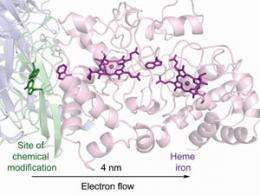Minnesota researchers discover how electricity moves through cells

(PhysOrg.com) -- Researchers at the University of Minnesota have created a molecular image of a system that moves electrons between proteins in cells. The achievement is a breakthrough for biology and could provide insights to minimize energy loss in other systems, from nanoscale devices to moving electricity around the country.
The research, led by Carrie Wilmot, an associate professor in the College of Biological Sciences, is published in the March 12 issue of Science.
"Evolution has been fine-tuning electricity in organisms for a lot longer than humans have been using it," Wilmot says. "We can learn a lot from nature about how to use it more efficiently. This new glimpse at how the body uses electricity could lead to nanotechnology to shrink electronic circuitry even further or a more efficient grid to provide power to homes and businesses."
Energy generated by intracellular movement of electrons is the fundamental power source that enables humans to exist. As electrons move within cells, energy is channeled to create complex molecules, such as protein and DNA. These are the building materials that enable organisms to grow, maintain themselves, and store energy. Wilmot's images, obtained using x-ray crystallography, will advance the effort to understand this process better.
"Obtaining a crystal structure of a complex cellular electron transfer system is like being behind stage at a magic show," says Vernon Anderson, who oversees biochemistry grants at the National Institutes of Health's National Institute of General Medical Sciences. "We have always known there was a trick, but now the Wilmot group has provided a unique view of how this extraordinary chemical feat is accomplished."
Wilmot, an associate professor in the College of Biological Sciences, is known in the scientific community for pioneering a technique to freeze biological catalysts (enzymes) as they accelerate and orchestrate chemical reactions. This produces snapshots at different points during the reaction that can be viewed as frames in a movie that defines the molecular and structural changes that occur as the chemistry unfolds.
Provided by University of Minnesota
















